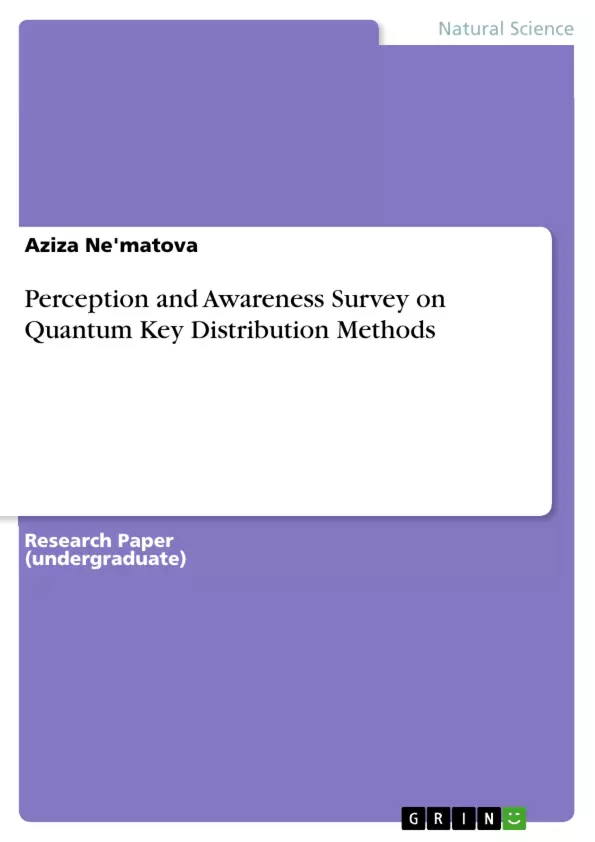Quantum Computing uses specialized technology, including computer hardware and algorithms that take advantage of quantum mechanics to solve complex problems that classical computers or supercomputers can’t solve, or can’t solve quickly enough. Quantum Cryptography, specifically Quantum Key Distribution (QKD), employs techniques from Quantum Computing to perform cryptographic tasks, with QKD offering to solve the key exchange problem.
We survey a group of school-aged participants, and show that presenting descriptions of various QKD protocols exhibits an increase in subjective assessment of their understanding of QKD, along with an increase in trust of the protocols demonstrated. This potentially underlines the importance of public education for enabling popular adoption of novel applications for QKD.
Inhaltsverzeichnis (Table of Contents)
- Introduction
- Basic notions of cryptography
- Quantum Cryptography
- Key distribution
- Quantum Key Distribution (QKD)
- QKD protocols
- Coherent-One-Way Quantum Key Distribution
- Differential-Phase-Shift Quantum Key Distribution
- Decoy-State Quantum Key Distribution
- Literature review
- Research Questions
- Methodology
- Understanding QKD protocols
- Research and analysis on how to conduct a perception survey
- Survey planning
- Survey Development
- Survey Participants
- Ethical Considerations
- Results
- Participants
Zielsetzung und Themenschwerpunkte (Objectives and Key Themes)
This research aims to assess the general public's understanding of Quantum Cryptography and Quantum Key Distribution (QKD) through a survey, analyzing the impact of demographic factors and exploring changes in perception after providing basic information about the technology.
- Public perception of Quantum Computing and Quantum Key Distribution
- Influence of demographic factors on perceptions and acceptance of QKD
- Impact of providing basic information about QKD on public perceptions of its security and reliability
- Comparison and analysis of different QKD protocols
- Importance of public education for the adoption of QKD applications
Zusammenfassung der Kapitel (Chapter Summaries)
The introduction provides a foundation by defining fundamental concepts such as cryptography, quantum cryptography, key distribution, and Quantum Key Distribution (QKD). It outlines the importance of QKD for addressing the key exchange problem in secure communication and introduces the three key QKD protocols: Coherent-One-Way (COW) QKD, Differential-Phase-Shift (DPS) QKD, and Decoy-State QKD.
The literature review explores existing research on QKD protocols, their implementations in long-distance and satellite experiments, and the gap between perceived and actual security. It highlights the lack of specific studies targeting QKD and emphasizes the significance of addressing this gap.
The research questions define the study's core objectives, focusing on understanding the general public's familiarity with Quantum Computing and QKD, assessing the influence of demographic factors on perceptions, and investigating how providing information about QKD affects perceptions of its security and reliability.
The methodology section outlines the survey development process, detailing the selection of QKD protocols, the review of perception surveys, and the planning and structure of the online survey using Google forms. It describes the survey's objectives, participant recruitment, ethical considerations, and data collection methods.
Schlüsselwörter (Keywords)
The research revolves around key concepts such as Quantum Cryptography, Quantum Key Distribution, QKD protocols, public perception, demographic factors, security, reliability, and the gap between perceived and actual security. The study focuses on investigating the understanding and acceptance of QKD among the general public, emphasizing the importance of public education and awareness for the successful adoption of this emerging technology.
- Citation du texte
- Aziza Ne'matova (Auteur), 2024, Perception and Awareness Survey on Quantum Key Distribution Methods, Munich, GRIN Verlag, https://www.grin.com/document/1498200



